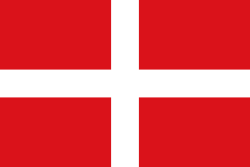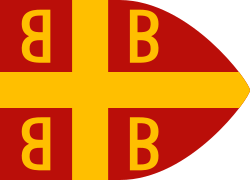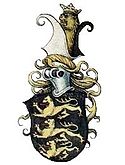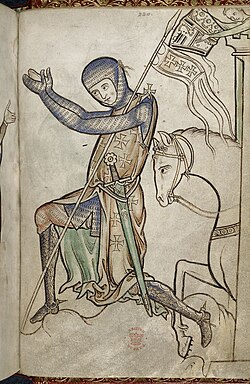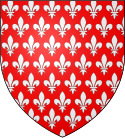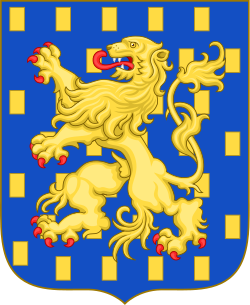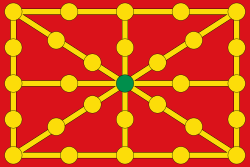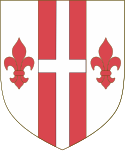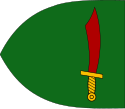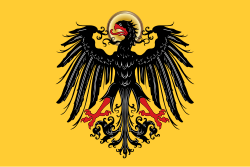Bitva u Nikopole
V bitvě u Nikopole se 25. září 1396 střetli osmanští Turci s křižáckým vojskem tvořeným především Francouzi, Uhry, Chorvaty, Němci, Burgunďany, Bulhary, Benátčany aj. Tažení evropských sil vedených uherským králem Zikmundem Lucemburským, označované někdy jako Nikopolská křížová výprava, v tomto boji drtivě podlehlo početnějšímu turecko-srbskému vojsku osmanského sultána Bájezída I. nedaleko pevnosti Nikopolis na bulharském území.


Selhání tohoto podniku ze strany evropských křižáků se přičítá nejednotné taktice jejich společného vojska, zejména francouzským účastníkům, tj. zbrklosti rytířů z Francie, kteří provedli předčasný unáhlený výpad proti osmanským silám, bitva se pak už vyvíjela jen v neprospěch křižácké strany vedoucí až ke katastrofální porážce. Pouze malá část křižáků včetně krále Zikmunda Lucemburského se zachránila, většina padla na bojišti a část se octla v tureckém zajetí, kde byli poté popraveni. Znamenalo to také konec nadějí na záchranu skomírající Byzantské říše a balkánských národů, které ani společnými silami nemohly vzdorovat vzrůstající osmanské moci.
Literatura
- KOVAŘÍK, Jiří. Čas stoleté války : (1356–1450) : rytířské bitvy a osudy III. Praha: Mladá fronta, 2006. 346 s. ISBN 80-204-1499-1.
Externí odkazy
 Obrázky, zvuky či videa k tématu Bitva u Nikopole na Wikimedia Commons
Obrázky, zvuky či videa k tématu Bitva u Nikopole na Wikimedia Commons
Média použitá na této stránce
According to Rıza Nur, sultan Selim I (1512-20) had a white personal flag, while the Ottoman Army flag was red (kızıl bayrak). During Süleyman I's reign (1520-66) the janissaries had a white flag while the timariot cavalry had a red flag. It was used as the Ottoman civic and merchant flag from 1793 to 1923.
Red_St_George's_Cross
Used by Archbishopric-Electorate of Trier 898–1794 (Erzbistum Trier)
Autor: Oren neu dag (talk), Licence: CC BY-SA 3.0
Royal flag of France before the Revolution (heraldic banner of "France modern")
Autor: Oren neu dag (talk), Licence: CC BY-SA 3.0
Royal flag of France before the Revolution (heraldic banner of "France modern")
Flag of Genoa
Autor: Samhanin, Licence: CC0
Flag of the Second Bulgarian Empire (Ivan Shishman of Bulgaria Era, 1380). as shown in the Guillem Soler.
Autor: Cplakidas, Licence: CC BY-SA 3.0
The Byzantine imperial ensign (βασιλικόν φλάμουλον), as depicted in the 14th-century Castilian Book of All Kingdoms, and described in the Treatise on Offices by the mid 14th-century Byzantine writer Pseudo-Kodinos as being hoisted on imperial naval vessels. It features the tetragrammic cross with the four "B"s that is attested in contemporary portolans, on coins and reliefs.
Autor: Tento vektorový obrázek byl vytvořen programem Inkscape ., Licence: CC BY-SA 3.0
Flag of Bulgaria (i.e Vidin), used in the 14th century.
Autor: Tento vektorový obrázek byl vytvořen programem Inkscape od v ., Licence: CC BY-SA 3.0
Royal Banner of the Kingdom and Crown of Aragón
Autor: Government of Scotland, according to Lyon King of Arms Act 1672
(Vector graphics image by Eyrian), Licence: CC BY-SA 3.0
The Royal Banner of Scotland, also known as the "Lion Rampant", is the banner of the old arms of the King of Scots. It consists of a lion contained within a "tressure flory counter-flory" (In heraldic terminology, it is blazoned as Or, a lion rampant Gules armed and langued Azure within a double tressure flory counter-flory Gules
- English Royal Banner: Royal Banner of England.svg
Arms of the Emperor of Bulgaria, by Miltenberger Wappenbuch (14th century).
A kneeling knight with his horse before setting off on the crusades. His servant leaning over the turret with his masters helmet.From the Westminster Psalter, BL Royal MS 2 A xxii f. 220
Autor: Dbachmann, Licence: CC BY-SA 3.0
Early form of the Swiss flag, used as a field sign by troops under confederate command from ca. the 1470s. This was replaced by various flammé designs during the 17th century, but this older design was taken as the basis for the modern flag of 1815.
Drawn after the earliest depiction of the field sign, in the Lucerne Chronicle of 1513, in the scene showing the battle of Nancy (1477), see File:Deutsche Geschichte5-290.jpg.
A triangular version of the flag saw slightly earlier use, possibly from the 1420s, see File:Ch-1422a.png, and File:St. Jakob Tschachtlan.jpg for a 1470 depiction of the triangular flag in a scene of 1444.Arms of Mircea the Elder of Wallachia
Autor: See File history, below for details., Licence: CC BY-SA 3.0
Coat of arms of Sigismund, Holy Roman Emperor.
Arms of Bohemia ![]() quartered with Hungary
quartered with Hungary ![]()
Autor: Samhanin, Licence: CC0
Coat of arms of Branković family (small)
Autor: Oren neu dag (diskuse), Licence: CC BY-SA 3.0
Ancient Flag of Burgundy
Banner of Basarab princely Wallachian family, XV-th century.
Autor: Heralder, Licence: CC BY-SA 3.0
Royal Standard of the Crown of Castile (15th Century Style)
Autor: Samhanin & Havsjö (change the color of the 'Royal banner of the Kingdom of Bohemia.svg'), Licence: CC BY-SA 4.0
Royal banner of the Kingdom of Bohemia (1305)
Flag of the State of the Teutonic Order
Banner of Kingdom of Poland in the 14th century
A seal of Duke Premislaus II from 1290 shows the ruler holding a banner emblazoned with a crowned eagle. During the reign of King Ladislaus (r. 1320–1333), the red cloth with the White Eagle was established as the royal banner. The orientation of the eagle on the banner varied; its head could point either upwards or towards the hoist.
Autor: Carlodangio, Licence: CC BY-SA 4.0
Autor: Miguillen, Licence: CC BY-SA 4.0
Bandera de Navarra (versión antigua)
Autor: Kolomaznik, Licence: CC BY-SA 4.0
Původní znak rodu Hrebeljanovićů před převzetím znaku dynastie Nemanjić.
Autor: Samhanin, Licence: CC BY 3.0
Flag of Croatia (Early 16th century–1526) per source, which is historically innacurate as such a flag or coat of arms was used only since 1527 when the Croatian nobility elected the Habsburg dynasty.
Autor: Constantine Plakidas, Licence: CC BY-SA 4.0
Coat of arms of the Knights Hospitaller
Flag of Siluana (Transylvania), around 1350, according to the story of a Spanish Franciscan friar:
- From Maxar I went to the Kingdom of Siluana, which they call Septen Castra, and the Greeks call it Horgiml (Transylvania). It is encircled by two great rivers — the Turbo (Dniester) and the Lusim (Dnieper). The king has for his device a green flag with a red scimitar. The people are schismatic Christians.
Autor: Kandi, Licence: CC BY-SA 4.0
Plan of the Battle of Nicopolis (1396)
Autor: Ddurbmonnejg, Licence: CC BY-SA 4.0
Naval and land fortifications flag of the Republic of Venice (XIV century)
One of the coats of arms of the Counts of Celje. It was in use since Frederick II.
Autor: Silverije, Licence: CC BY-SA 3.0
Coat of arms of Lacković (Lackfi) noble family (Croatia)
Anachronistic representation of the royal banner of the 12th(?) or 13th to early 15th centuries.
The banner of this period would be square in shape, and the eagle would not have a halo.
The black eagle in a golden field was the ensign of the German kings (as opposed to the emperor) in the 12th and 13th century, but in the 14th century, it was gradually re-interpreted as representing the empire. An early reference to such a banner as "imperial" is made in an account of the burial of Charles IV (d. 1378), as der schwartz adler des richs in einem guldin veld .Autor: Tento vektorový obrázek byl vytvořen programem Inkscape ., Licence: CC BY-SA 3.0
Coat of arms of Stibor of Stiboric
State Flag of the Savoyard States (late 16th - late 18th century).
Vectorization of the 1495 Coat of arms of Croatia. It was officially used only since 1527, after the Croatian nobility elected the Habsburg dynasty.





